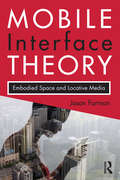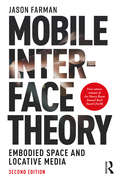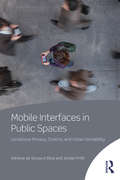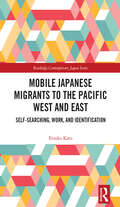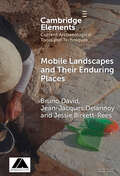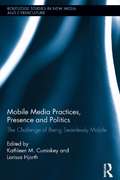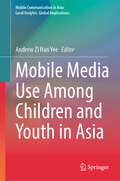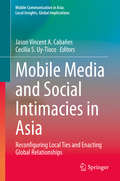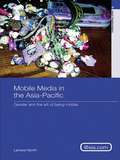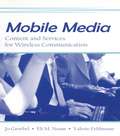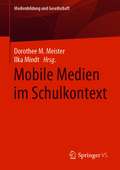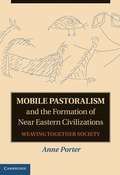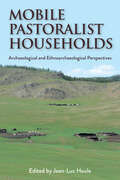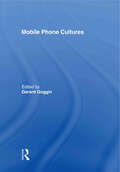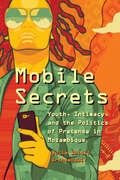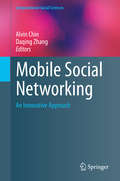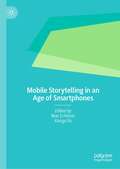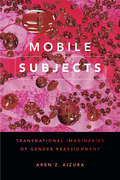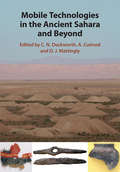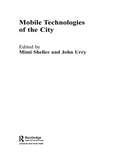- Table View
- List View
Mobile Homes: Spatial and Cultural Negotiation in Asian American Literature (Studies In Asian Americans Ser.)
by Su-Ching HuangThe writers discussed in the book include Chiang Yee, Hualing Nieh, David Wong Louie, Fae Myenne Ng, John Okada, and Toshio Mori. Their publication dates span from the 1940s up to 2000.
Mobile Interface Theory: Embodied Space and Locative Media
by Jason FarmanMobile media – from mobile phones to smartphones to netbooks – are transforming our daily lives. We communicate, we locate, we network, we play, and much more using our mobile devices. In Mobile Interface Theory, Jason Farman demonstrates how the worldwide adoption of mobile technologies is causing a reexamination of the core ideas about what it means to live our everyday lives. He argues that mobile media’s pervasive computing model, which allows users to connect and interact with the internet while moving across a wide variety of locations, has produced a new sense of self among users – a new embodied identity that stems from virtual space and material space regularly enhancing, cooperating or disrupting each other. Exploring a range of mobile media practices – including mobile maps and GPS technologies, location-aware social networks, urban and alternate reality games that use mobile devices, performance art, and storytelling projects – Farman illustrates how mobile technologies are changing the ways we produce lived, embodied spaces.
Mobile Interface Theory: Embodied Space and Locative Media
by Jason FarmanIn this updated second edition, Jason Farman offers a groundbreaking look at how location-aware mobile technologies are radically shifting our sense of identity, community, and place-making practices. Mobile Interface Theory is a foundational book in mobile media studies, with the first edition winning the Book of the Year Award from the Association of Internet Researchers. It explores a range of mobile media practices from interface design to maps, AR/VR, mobile games, performances that use mobile devices, and mobile storytelling projects. Throughout, Farman provides readers with a rich theoretical framework to understand the ever-transforming landscape of mobile media and how they shape our bodily practices in the spaces we move through. This fully updated second edition features updated examples throughout, reflecting the shifts in mobile technology. This is the ideal text for those studying mobile media, social media, digital media, and mobile storytelling.
Mobile Interfaces in Public Spaces: Locational Privacy, Control, and Urban Sociability
by Adriana de Souza e Silva Jordan FrithMobile phones are no longer what they used to be. Not only can users connect to the Internet anywhere and anytime, they can also use their devices to map their precise geographic coordinates – and access location-specific information like restaurant reviews, historical information, and locations of other people nearby. The proliferation of location-aware mobile technologies calls for a new understanding of how we define public spaces, how we deal with locational privacy, and how networks of power are developed today. In Mobile Interfaces in Public Spaces, Adriana de Souza E. Silva and Jordan Frith examine these social and spatial changes by framing the development of location-aware technology within the context of other mobile and portable technologies such as the book, the Walkman, the iPod, and the mobile phone. These technologies work as interfaces to public spaces – that is, as symbolic systems that not only filter information but also reshape communication relationships and the environment in which social interaction takes place. Yet rather than detaching people from their surroundings, the authors suggest that location-aware technologies may ultimately strengthen our connections to locations.
Mobile Japanese Migrants to the Pacific West and East: Self-searching, Work, and Identification (Routledge Contemporary Japan Series)
by Etsuko KatoThis book explores “self-searching migrants,” a new group of indefinitely globally mobile people whose purpose of overseas stay is the search of true self and the work they really want to do, using Japanese trans-Pacific sojourners as the case study. Utilizing testimonies collected from interviews with Japanese migrants in their twenties to forties who had entered the job market between the early 1990s and 2010 and left for the English-speaking countries of Canada, Australia, and Singapore, the book argues that their practices are both ubiquitous and unique, the products of global and local contexts of a specific time. As semiskilled migrants from an extra-Western, postindustrial country, their struggles show a different picture of the West-centric world power system from those experienced by migrant workers from the Global South. Including extensive qualitative research and interview material collected over a 20-year period, this book will be of huge interest to students and scholars of Japanese culture and society, cultural anthropology, and migration.
Mobile Landscapes and Their Enduring Places (Elements in Current Archaeological Tools and Techniques)
by Bruno David Jean-Jacques Delannoy Jessie Birkett-ReesThis Element presents emerging concepts and analytical tools in landscape archaeology. In three major sections bookended by an Introduction and Conclusion, the Element discusses current and emerging ideas and methods by which to explore how people in the past engaged with each other and their physical settings across the landscape, creating their lived environments in the process. The Element reviews the scales and temporalities that inform the study of human movements in and between places. Learning about how people engaged with each other at individual sites and across the landscape deep in the past is best achieved through transdisciplinary approaches, in which archaeologists integrate their methods with those of other specialists. The Element introduces these ideas through new research and multiple case studies from around the world, culminating in how to 'archaeomorphologically' map anthropic constructions in caves and their contemporary environments.
Mobile Lives (International Library of Sociology)
by John Urry Anthony ElliottHow should we understand the personal and social impacts of complex mobility systems? Can lifestyles based around intensive travel, transport and tourism be maintained in the 21st century? What possibility post-carbon lifestyles? In this provocative study of "life on the move", Anthony Elliott and John Urry explore how complex mobility systems are transforming everyday, ordinary lives. The authors develop their arguments through an analysis of various sectors of mobile lives: networks, new digital technologies, consumerism, the lifestyles of ‘globals’, and intimate relationships at-a-distance. Elliott and Urry introduce a range of new concepts – miniaturized mobilities, affect storage, network capital, meetingness, neighbourhood lives, portable personhood, ambient place, globals – to capture the specific ways in which mobility systems intersect with mobile lives. This book represents a novel approach in "post-carbon" social theory. It will be essential reading for advanced undergraduate students, postgraduates and teachers in sociology, social theory, politics, geography, international relations, cultural studies, and economics and business studies.
Mobile Media Practices, Presence and Politics: The Challenge of Being Seamlessly Mobile (Routledge Studies in New Media and Cyberculture)
by Larissa Hjorth Kathleen M. CumiskeyAs an example of convergence, the mobile phone—especially in the form of smartphone—is now ushering in new promises of seamlessness between engagement with technology and everyday common experiences. This seamlessness is not only about how one transitions between the worlds of the device and the physical environment but it also captures the transition and convergences between devices as well (i.e. laptop to smartphone, smartphone to tablet). This volume argues, however, that these transitions are far from seamless. We see divisions between online and offline, virtual and actual, here and there, taking on different cartographies, emergent forms of seams. It is these seams that this volume acknowledges, challenges and explores—socially, culturally, technologically and historically—as we move to a deeper understanding of the role and impact of mobile communication’s saturation throughout the world.
Mobile Media Use Among Children and Youth in Asia (Mobile Communication in Asia: Local Insights, Global Implications)
by Andrew Zi Han YeeThis book examines mobile media use among children and youths within an Asian context. By studying the impact of mobile media on children and youth in Asia, it focuses on the explosive growth of mobile media among young people and seeks to understand the potential consequences of mobile media use on society, relationships, and what it means to be a young person. With this, it provides a richly contextualized Asian voice to research on mobile media and young people, enriching the global conversation surrounding an increasingly central aspect of youths’ everyday lives. Research on mobile media and its impact on children and youths in Asia is not thoroughly represented, despite the proliferation of smartphone and tablet use in the region. This volume fills this gap by canvassing contemporary research on mobile media, children, and youth in Asia through the perspectives of emerging scholars in the region and beyond. It promotes an understanding of the motivations and patterns of use by children and youth in the region, examines contemporary research on the antecedents and consequences of mobile media use on society, relationships, and the individual, and provides a critique of mobile media use among children and youth. The volume also provides a culturally sensitive examination of mobile media use among children and youth, describing and analyzing policies enacted to manage young people’s smartphone use. It acknowledges Asia as a large and diverse region with differing linguistic, cultural, and sociopolitical traditions and contexts, and so the work does, as far as possible, look to ensure geographic and cultural diversity by prioritizing works from countries that are typically underrepresented. It is a relevant text to graduates and researchers in communication and media studies, social and developmental psychology, human development studies, science and technology, information systems, and design science.
Mobile Media and Social Intimacies in Asia: Reconfiguring Local Ties and Enacting Global Relationships (Mobile Communication in Asia: Local Insights, Global Implications)
by Jason Vincent A. Cabañes Cecilia S. Uy-TiocoThis edited volume brings together cutting-edge studies from emerging scholars of East/Southeast Asia who explore the role of mobile media in the contemporary transformation of the region’s social intimacies, from the romantic to the familial to the communal. By providing a regional and transnational overview of such studies, it affords new insights into how these mobile technologies have contributed to the rise of ‘glocal intimacies’. This pertains to the normalisation and intensification of how people’s relationships of closeness are entangled in the ever-shifting and constantly negotiated flows between global modernity and local everyday life. In providing case studies of mobile media and glocal intimacies, the chapters in the volume attend to a broad range of countries that include China, Korea, Malaysia, the Philippines, Singapore, Vietnam, and Taiwan. This illustrates the differing ways in which mobile media might be embedded in the region’s divergent articulations of social intimacies, which reflect the ongoing tensions between Western and Asian imaginaries of modernity. The chapters also discuss a wide array of mobile media that people use, from social media platforms like Facebook and Instagram, to messaging apps like KakaoTalk and WhatsApp, to dating apps like Tinder and Blued. This allows for a mapping out of the different levels of impact that mobile media might have on social intimacies in a region that contains some of the most technologically advanced as well as the most technologically behind societies in the world. In summary, this book allows readers to take a comparative approach to understanding the complexity of the glocal intimacies that are emerging from the ways people in Asia use mobile media to reconfigure their local ties and to enact global relationships. This volume will benefit students, academics, and researchers who are keen in media and communication, cultural studies, sociology, anthropology, and Asian studies. “This exciting and much-needed book will greatly advance our efforts to decolonise media and communications research. The chapters offer empirically rich and nuanced accounts that challenge the dominant paradigms about mediated intimacy.”Mirca Madianou, Goldsmiths, University of London “This collection develops the original concept of ‘glocal intimacies’ to describe how mobile media have become a crucial site where new social intimacies are enacted, reinforced and transformed in Asia. It introduces fresh empirical research from emerging scholars to furnish deep theoretical insights into these imaginaries and practices.” Audrey Yue, National University of Singapore
Mobile Media in the Asia-Pacific: Gender and The Art of Being Mobile (Asia's Transformations/Asia.com)
by Larissa HjorthThis century has been marked by the rapid and divergent uptake of mobile telephony throughout the world. The mobile phone has become a poignant symbol for postmodernity and the attendant modes of global mobility and immobility. Most notably, the icon of the mobile phone is most palpable in the Asia-Pacific in which a diversity of innovation and consumer practices – reflecting gender and locality – can be found. Through the lens of gendered mobile media, Mobile Media in the Asia Pacific provides insight into this phenomenon by focusing on case studies in Japan, South Korea, China and Australia. Despite the ubiquity and multi-layered nature of mobile media in the region, the patterns of female consumption have received little attention in the growing literature on mobile communication globally. Utilising ethnographic research conducted in the Asia-Pacific over a six-year period, this book investigates the relationship between gender, technology and various forms of mobility and immobility in the region. This book outlines the emerging modes of gender performativity that makes the Asia-Pacific region so distinct to other regions globally. Mobile Media in the Asia Pacific is a fascinating read for students and scholars interested in new media and gender in the Asia-Pacific region.
Mobile Media: Content and Services for Wireless Communications (European Institute for the Media Series)
by Eli M. Noam Jo Groebel Valerie FeldmannThe proliferation of mobile media in recent years is an international phenomenon, with billions of devices sold annually. Mobile communications are now moving beyond individualized voice to mass media content--text, voice, sound, images, and even video. This will create new types of content that allow media companies and users to interact in new ways. There is a strong interest from the media and telecom industries in what manner of applications and content can be distributed in that fashion, and at what cost. To answer these questions, the book provides 18 chapters from internationally renowned authors. They identify likely types of content such as news, entertainment, peer-to-peer, and location-specific information; evaluate the economics, business models, and payment mechanisms necessary to support these media; and cover policy dimensions such as copyright, competitiveness, and access rights for content providers.This volume takes the reader through the various elements that need to be considered in the development of third generation (3G) content, and explains pitfalls and barriers. The result is a volume of interest to business professionals, academics, and policy makers.The book is international in focus and a glossary of terms is provided. There are few publications available which give an overview of this rapidly changing field.
Mobile Medien im Schulkontext (Medienbildung und Gesellschaft #41)
by Dorothee M. Meister Ilka MindtDer Band beleuchtet sowohl aus medienpädagogischer als auch aus fachwissenschaftlicher und fachdidaktischer Sicht den Stand und die Perspektiven des mobilen Medieneinsatzes an Schulen. Der schulische Kontext ist gefordert, Digitalisierungstrends aufzugreifen, und zwar durch ein Lernen mit, über und durch Medien. Da inzwischen mobile Geräte immer mehr zum Schulalltag dazugehören, ist zu klären, welche Konzepte den Einsatz begründen und wie konkret mobile Geräte sinnvoll in den Unterricht integriert werden können.
Mobile Methods
by Monika BüscherIn the twenty-first century, more than ever, everything and everybody seems to be on the move. Global flows of people, goods, food, money, information, services and media images are forming an intensely mobile background to everyday life. Social scientists, too, are on the move, seeking new analytical purchase on these important aspects of the social world by trying to move with, and to be moved by, the fleeting, distributed, multiple, non-causal, sensory, emotional and kinaesthetic. Mobile Methods addresses the challenges and opportunities of researching mobile phenomena. Drawing on extensive interdisciplinary discussion, the book brings together a collection of cutting-edge methodological innovations and original research reports to examine some important implications of the mobilities turn for the processes of ‘research’, and the realm of the empirical. Through analysis that addresses questions such as ‘how are social relationships and social institutions made in and through mobility?’, and ‘how do people experience mobility in twenty-first century world cities?', the authors mobilize sociological analysis, bringing new insights and opening up new opportunities for engagement with contemporary challenges. This book is a key text for undergraduate and postgraduate students of disciplines including Human Geography, Social Policy, Sociology and Research Methods.
Mobile Narratives: Travel, Migration, and Transculturation (Routledge Interdisciplinary Perspectives on Literature #18)
by Jopi Nyman Eleftheria Arapoglou Mónika FodorEmphasizing the role of travel and migration in the performance and transformation of identity, this volume addresses representations of travel, mobility, and migration in 19th–21st-century travel writing, literature, and media texts. In so doing, the book analyses the role of the various cultural, ethnic, gender, and national encounters pertinent to narratives of travel and migration in transforming and problematizing the identities of both the travelers and "travelees" enacting in the borderzones between cultures. While the individual essays by scholars from a wide range of countries deal with a variety of case studies from various historical, spatial, and cultural locations, they share a strong central interest in the ways in which the narratives of travel contribute to the imagining of ethnic encounters and how they have acted as sites of transformation and transculturation from the early nineteenth century to the present day. In addition to discussing textual representations of travel and migration, the volume also addresses the ways in which cultural texts themselves travel and are reconstructed in various cultural settings. The analyses are particularly attentive to the issues of globalization and migration, which provide a general frame for interpretation. What distinguishes the volume from existing books is its concern with travel and migration as ways of forging transcultural identities that are able to subvert existing categorizations and binary models of identity formation. In so doing, it pays particular attention to the performance of identity in various spaces of cultural encounter, ranging from North America to the East of Europe, putting particular emphasis on the representation of intercultural and ethnic encounters.
Mobile Pastoralism and the Formation of near Eastern Civilizations
by Anne Porter"In this book, Anne Porter explores the idea that mobile and sedentary members of the ancient world were integral parts of the same social and political groups in greater Mesopotamia during the period 4000 to 1500 BCE. She draws on a wide range of archaeological and cuneiform sources to show how networks of social structure, political and religious ideology, and everyday as well as ritual practice, worked to maintain the integrity of those groups when the pursuit of different subsistence activities dispersed them over space. These networks were dynamic, shaping many of the key events and innovations of the time, including the Uruk expansion and the introduction of writing, so-called secondary state formation and the organization and operation of government, the literary production of the Third Dynasty of Ur and the first stories of Gilgamesh, and the emergence of the Amorrites in the second millennium BCE"--
Mobile Pastoralist Households: Archaeological and Ethnoarchaeological Perspectives
by Jean-Luc HouleMobile pastoralist activities occur at different scales across the landscape, including local, regional, and supra-regional scales. Most archaeological studies of mobile pastoralist social organization have focused on the latter two scales via the extant monumental and herding landscapes. Household levels of analysis figure much less in these studies. This volume brings together the work of archaeologists currently engaged in mobile pastoralist household research in different regions of the world to highlight the importance of household studies and the utility of both archaeological and ethnoarchaeological approaches in understanding mobile pastoralist household formation, continuity, and adaptation to environmental, social, economic, and political change.
Mobile Phone Cultures
by Gerard GogginWhat do we really know about mobile phone culture? This provocative and comprehensive collection explores the cultural and media dimensions of mobile phones around the world. An international team of contributors look at how mobiles have been imagined through advertising and social representations - tracing the scripting and shaping of the technology through gender, sexuality, religion, communication style - and explore the locations of mobile phone culture in modernity, urban settings and even transnational families. This book also provides a guide to convergent mobile phone culture, with fresh, innovative accounts of text messaging, Blackberry, camera phones, moblogging and mobile adventures in television. Mobile Phone Culture opens up important new perspectives on how we understand this intimate yet public cultural technology.Previously published as a special issue of Continuum: Journal of Media and Cultural Studies.
Mobile Secrets: Youth, Intimacy, and the Politics of Pretense in Mozambique
by Julie Soleil ArchambaultNow part and parcel of everyday life almost everywhere, mobile phones have radically transformed how we acquire and exchange information. Many anticipated that in Africa, where most have gone from no phone to mobile phone, improved access to telecommunication would enhance everything from entrepreneurialism to democratization to service delivery, ushering in socio-economic development. With Mobile Secrets, Julie Soleil Archambault offers a complete rethinking of how we understand uncertainty, truth, and ignorance by revealing how better access to information may in fact be anything but desirable. By engaging with young adults in a Mozambique suburb, Archambault shows how, in their efforts to create fulfilling lives, young men and women rely on mobile communication not only to mitigate everyday uncertainty but also to juggle the demands of intimacy by courting, producing, and sustaining uncertainty. In their hands, the phone has become a necessary tool in a wider arsenal of pretense—a means of creating the open-endedness on which harmonious social relations depend in postwar postsocialist Mozambique. As Mobile Secrets shows, Mozambicans have harnessed the technology not only to acquire information but also to subvert regimes of truth and preserve public secrets, allowing everyone to feign ignorance about the workings of the postwar intimate economy.
Mobile Social Networking
by Alvin Chin Daqing ZhangThe use of contextually aware, pervasive, distributed computing, and sensor networks to bridge the gap between the physical and online worlds is the basis of mobile social networking. This book shows how applications can be built to provide mobile social networking, the research issues that need to be solved to enable this vision, and how mobile social networking can be used to provide computational intelligence that will improve daily life. With contributions from the fields of sociology, computer science, human-computer interaction and design, this book demonstrates how mobile social networks can be inferred from users' physical interactions both with the environment and with others, as well as how users behave around them and how their behavior differs on mobile vs. traditional online social networks.
Mobile Storytelling in an Age of Smartphones
by Max Schleser Xiaoge XuThis book explores contemporary approaches to mobile storytelling, with contributions covering mobile education, news and screen storytelling, creative practice research, and the impact on vulnerable communities and social innovation. With 18 original chapters, Schleser and Xu bring together international media and communication scholars, digital storytellers, filmmakers, musicians, and educators to discuss the significant contributions made by mobile storytelling within academia, culture and society, resulting in a vibrant and interdisciplinary collection that will be a valuable resource to researchers across the arts, humanities and social sciences. This edited collection is a result of the collaboration between Mobile Studies International (MSI) and the Mobile Innovation Network & Association (MINA) at the International Mobile Storytelling Congress (IMSC) at the University of Nottingham Ningbo China.
Mobile Subjects: Transnational Imaginaries of Gender Reassignment (Perverse Modernities: A Series Edited by Jack Halberstam and Lisa Lowe)
by Aren Z. AizuraThe first famous transgender person in the United States, Christine Jorgensen, traveled to Denmark for gender reassignment surgery in 1952. Jorgensen became famous during the ascent of postwar dreams about the possibilities for technology to transform humanity and the world. In Mobile Subjects Aren Z. Aizura examines transgender narratives within global health and tourism economies from 1952 to the present. Drawing on an archive of trans memoirs and documentaries as well as ethnographic fieldwork with trans people obtaining gender reassignment surgery in Thailand, Aizura maps the uneven use of medical protocols to show how national and regional health care systems and labor economies contribute to and limit transnational mobility. Aizura positions transgender travel as a form of biomedical tourism, examining how understandings of race, gender, and aesthetics shape global cosmetic surgery cultures and how economic and racially stratified marketing and care work create the ideal transgender subject as an implicitly white, global citizen. In so doing, he shows how understandings of travel and mobility depend on the historical architectures of colonialism and contemporary patterns of global consumption and labor.
Mobile Technologies in the Ancient Sahara and Beyond (Trans-Saharan Archaeology)
by A. Cuénod C. Duckworth D. MattinglyThe ancient Sahara has often been treated as a periphery or barrier, but this agenda-setting book – the final volume of the Trans-Saharan Archaeology Series – demonstrates that it was teeming with technological innovations, knowledge transfer, and trade from long before the Islamic period. In each chapter, expert authors present important syntheses, and new evidence for technologies from oasis farming and irrigation, animal husbandry and textile weaving, to pottery, glass and metal making by groups inhabiting the Sahara and contiguous zones. Scientific analysis is brought together with anthropology and archaeology. The resultant picture of transformations in technologies between the third millennium BC and the second millennium AD is rich and detailed, including analysis of the relationship between the different materials and techniques discussed, and demonstrating the significance of the Sahara both in its own right and in telling the stories of neighbouring regions.
Mobile Technologies of the City (Networked Cities Series)
by Mimi Sheller John UrryMobile communications technologies are taking off across the world, while urban transportation and surveillance systems are also being rebuilt and updated. Emergent practices of physical, informational and communicational mobility are reconfiguring patterns of movement, co-presence, social exclusion and security across many urban contexts. This book brings together a carefully selected group of innovative case studies of these mobile technologies of the city, tracing the emergence of both new socio-technical practices of the city and of a new theoretical paradigm for mobilities research.
Mobile Technologies: From Telecommunications to Media (Routledge Research in Cultural and Media Studies)
by Larissa Hjorth Gerard GogginIn light of emerging forms of software, interfaces, cultures of uses, and media practices associated with mobile media, this collection investigates the various ways in which mobile media is developing in different cultural, linguistic, social, and national settings. Specifically, contributors consider the promises and politics of mobile media and its role in the dynamic social and gender relations configured in the boundaries between public and private spheres. The collection is genuinely interdisciplinary, as well as international in its range, with contributors and studies from China, Japan, Korea, Italy, Norway, France, Belgium, Britain, and Australia.

